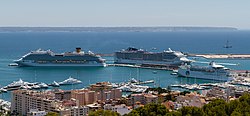This article needs additional citations for verification .(January 2024) |

Transport in Spain is characterised by a network of roads, railways (including having high speed rail network that is the second longest in the world), trams, air routes, and ports. Its geographic location makes it an important link between Europe, Africa, and the Americas. Major forms of transit generally radiate from the capital, Madrid, located in the centre of the country, to link with the capitals of the autonomous communities.
Contents
- Rail transport and AVE transport
- Cities with metro/light rail systems
- Railway links with adjacent countries
- High-speed rail
- Road system
- Road safe system
- Waterways
- Pipelines
- Ports and harbors
- Merchant marine
- Air transport
- Airports – with paved runways
- Airports – with unpaved runways
- Airlines based in Spain
- Heliports
- See also
- References
Spanish transit is marked by a high degree of integration between its long-distance railway system and inner-city metro systems, although the historic use of broad gauge has limited integration with its neighbours. Spain is currently working to increase and improve linkage with the rail systems of France and Portugal, including the high-speed rail line between Madrid and Lisbon. [1]

Spain's highway system is developed, with both tolled and free motorways.[ citation needed ] Air traffic is routed through several international and regional airports, the largest of which is Barajas International Airport in Madrid.












